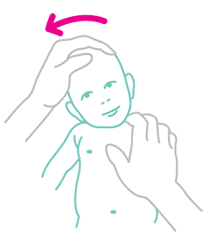Children's Emergency Department is now located in Children's Tower: 1001 E. Marshall Street.
Learn moreTorticollis is a common problem marked by limited neck motion. An infant or child with this condition tends to hold their head to one side with their ear tilted toward their shoulder.
Over time, torticollis can cause a shortening of a muscle in the neck, called the sternocleidomastoid muscle, which runs from the back of the ear to the bone between the shoulder and neck (collarbone). If it is severe and not treated, it can worsen and the child may develop difficulties with vision and walking. Torticollis may also lead to a flattened back of the head, which is a condition called plagiocephaly.
Torticollis may be caused by a baby’s position in the womb, crowding in the womb or injury to the muscle during delivery.
Parents may notice that the baby holds their head to one side and does not have a lot of neck movement.
Neck exercises and stretches done at home will usually treat torticollis. In some cases, physical therapy may be helpful.
Below are some neck exercises and changes in positioning that can be done at home. These can help increase the amount of movement, or range of motion, in a child’s neck.
The exercises should be done at each diaper change and other times during the day. Your child can be placed flat on the couch, changing table or on your lap when you do these. Over time you will need to increase the length of the stretch. This will be based on the baby, but the average amount of time to increase how far you stretch is about every five days. You will need to do these exercises until your baby has normal range of motion.
In this exercise, the head should be turned so the chin is touching the shoulder. To do this, place one hand on one side of your child’s face and the other on the shoulder on the same side. Gently and firmly move the chin to the opposite shoulder. Hold this position for 10 seconds. Repeat for three times. Do this on both sides.

Encourage lots of supervised tummy time while your baby is awake. Being on their tummy encourages an infant to develop stronger neck muscles.
Encourage your child to look both ways by changing where you place toys in their stroller, swing, crib or infant seat (alternate to different sides) and switching the hip you carry your child on. Looking both ways also strengthens neck muscles and can help increase how much the neck can move.